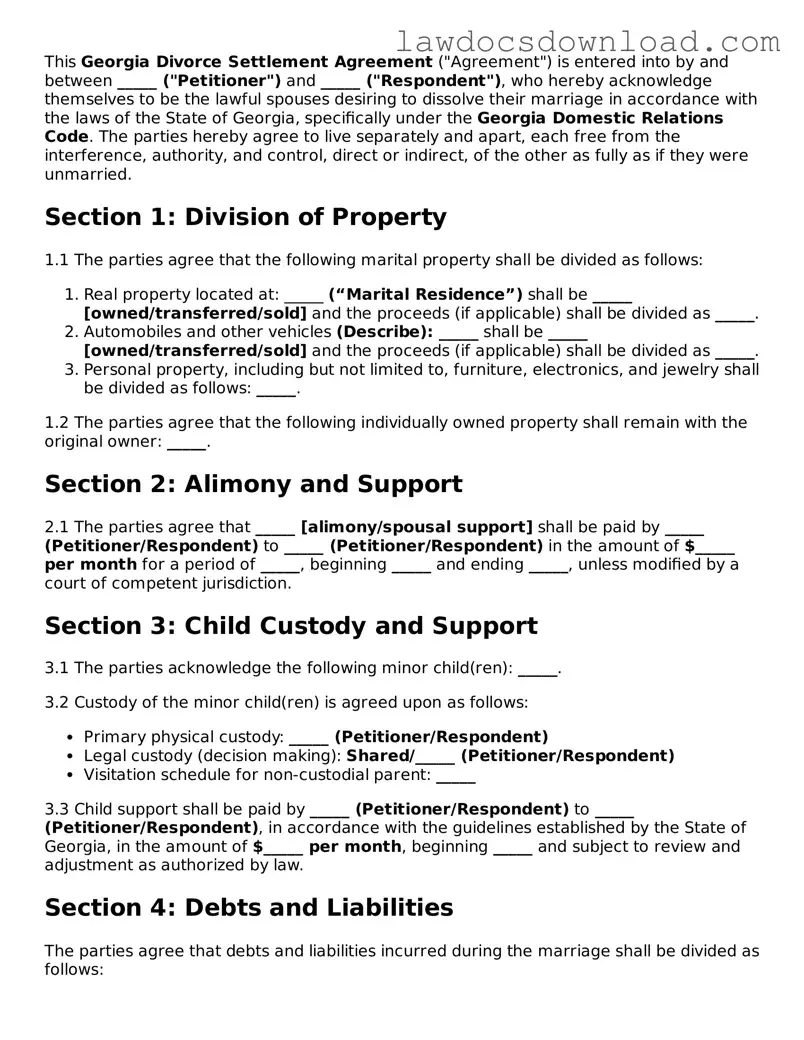This Georgia Divorce Settlement Agreement ("Agreement") is entered into by and between _____ ("Petitioner") and _____ ("Respondent"), who hereby acknowledge themselves to be the lawful spouses desiring to dissolve their marriage in accordance with the laws of the State of Georgia, specifically under the Georgia Domestic Relations Code. The parties hereby agree to live separately and apart, each free from the interference, authority, and control, direct or indirect, of the other as fully as if they were unmarried.
Section 1: Division of Property
1.1 The parties agree that the following marital property shall be divided as follows:
- Real property located at: _____ (“Marital Residence”) shall be _____ [owned/transferred/sold] and the proceeds (if applicable) shall be divided as _____.
- Automobiles and other vehicles (Describe): _____ shall be _____ [owned/transferred/sold] and the proceeds (if applicable) shall be divided as _____.
- Personal property, including but not limited to, furniture, electronics, and jewelry shall be divided as follows: _____.
1.2 The parties agree that the following individually owned property shall remain with the original owner: _____.
Section 2: Alimony and Support
2.1 The parties agree that _____ [alimony/spousal support] shall be paid by _____ (Petitioner/Respondent) to _____ (Petitioner/Respondent) in the amount of $_____ per month for a period of _____, beginning _____ and ending _____, unless modified by a court of competent jurisdiction.
Section 3: Child Custody and Support
3.1 The parties acknowledge the following minor child(ren): _____.
3.2 Custody of the minor child(ren) is agreed upon as follows:
- Primary physical custody: _____ (Petitioner/Respondent)
- Legal custody (decision making): Shared/_____ (Petitioner/Respondent)
- Visitation schedule for non-custodial parent: _____
3.3 Child support shall be paid by _____ (Petitioner/Respondent) to _____ (Petitioner/Respondent), in accordance with the guidelines established by the State of Georgia, in the amount of $_____ per month, beginning _____ and subject to review and adjustment as authorized by law.
Section 4: Debts and Liabilities
The parties agree that debts and liabilities incurred during the marriage shall be divided as follows:
- Mortgage on the marital residence: _____
- Automobile loans: _____
- Credit card debts: _____
- Other liabilities: _____
Section 5: General Provisions
5.1 This Agreement constitutes the entire agreement between the parties concerning the dissolution of their marriage and supersedes all prior agreements and understandings. Any amendments to this Agreement must be in writing and signed by both parties.
5.2 This Agreement shall be governed by and construed in accordance with the laws of the State of Georgia.
5.3 Each party hereby acknowledges that they have had the opportunity to seek independent legal and financial advice before signing this Agreement.
Signed this _____ day of _____, _____ (Year).
Petitioner's Signature: ___________________________ Date: _____
Respondent's Signature: __________________________ Date: _____
